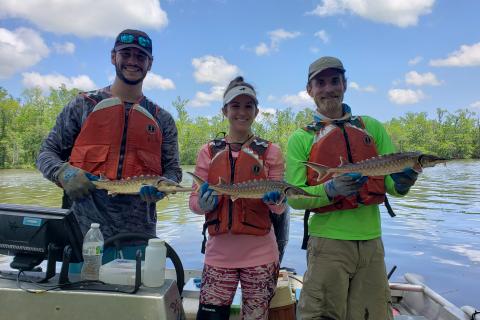Gulf sturgeon were once common in river systems from Tampa Bay to the Mississippi River. Historical overfishing, habitat loss, and many changing environmental factors have contributed to a drastic decline of sturgeon populations and their designation as a threatened species in 1991 under the Endangered Species Act. The Trustees found that Sturgeon populations were likely exposed to Deepwater Horizon oil in nearshore areas as they returned to the Gulf in cooler months after spawning in river systems upstream of the Gulf.
Since 2019, the Trustees have worked to restore Gulf sturgeon populations through three interconnected efforts—one restoration project (PDF, 162 pages) and two monitoring and adaptive management activities (one and two).
Due to restrictions during the COVID-19 pandemic, the Trustees were not able to complete field work as planned. The resulting lack of data would have negatively affected the overall goals of these efforts. Therefore, the Trustees approved a one-year extension and the funding needed to conduct an additional field season for two of its restoration efforts.
Characterizing Gulf Sturgeon Spawning Habitat, Habitat Use and Origins of Juvenile Sturgeon in the Pearl and Pascagoula Rivers System. In the Pearl and Pascagoula rivers systems, several existing barriers may be impeding Gulf sturgeons’ access to spawning habitat. This project is locating, mapping, and characterizing spawning substrates across nearly 1,000 miles of river channel and providing insights on whether spawning habitat is limited by these barriers.
This is difficult work; it requires detection of spawning habitat in large, sediment-laden rivers. To address these challenges, the project team is using side-scan sonar, which produces picture-like imagery of the underwater environment. To support the one-year extension (through 2025), the Trustees added $611,000 to the project budget.
Juvenile Gulf Sturgeon - Gulf-wide Population Dynamics and Habitat Use Monitoring and Adaptive Management Activity. This multi-year activity is assessing how, where, and when juvenile Gulf sturgeon use estuarine habitat. It is also assessing trends in sturgeon reproduction, growth, survival, and genetics across the Pearl, Pascagoula, Escambia, Yellow, Choctawhatchee, Apalachicola, and Suwanee river systems. To support the one-year extension (through 2024) the Trustees have added $524,000 to the project budget.
Visit the Open Ocean Restoration Area’s webpage for more information about the Open Ocean Trustee Implementation Group’s work.
Want to know more about Gulf Spill restoration efforts? Subscribe today to have news and updates delivered right to your inbox.


